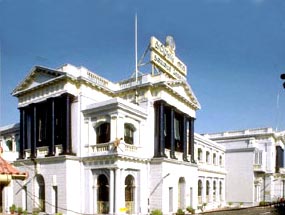Fort St George of Chennai was the first British
citadel in Tamil Nadu. Read on to get information on Saint George
Fort of Madras, India.
Fort St George

Location: Chennai, Tamil Nadu
Founded By: The British
Founded In: 1639
Fort St George claims the distinction of being the first fortress of
the British in India. The British founded this citadel, in the year
1639, at Chennai, presently the capital city of Tamil Nadu. With the
construction of the fort, the surrounding area also witnessed a surge in
the settlements as well as construction activities. Infact, one can say
that the present day city of Chennai (Madras) evolved around St George
Fort only. East India Company had initially entered India to indulge in
trade and commerce. Their first licensed trading started in the city of
Surat.
However, soon, the company decided to enter into the spice trade, for
which it was necessary to have a port nearer to the Malaccan Straits. A
strip of coastal land, called Madraspattinam, was purchased from a local
chieftain and the construction of a harbor and a fort began. The day, on
which the construction work on the fort was completed, coincided with
St. George's Day. This is the reason why the fort was named as Fort
Saint George. Soon, it became the heart of merchant activity &
developed into a new settlement area called George Town.
The town started expanding at a fast pace, including the surrounding
villages within itself. The expanding settlements finally evolved into
the present city of Chennai. Fort St George is surrounded by walls that
are 6 m high and have endured numerous assaults in the 18th century. The
fort also came into the possession of the French. However, the French
control lasted for a period of three years only, from 1746 to 1749. Fort
St George was then restored to the British under the Treaty of
Aix-la-Chapelle.
In order to prevent outsiders from entering the premises of the fort,
the British got a moat built around it. The area inside the moat was
named as 'The White Town'. Fort Saint George boasts of a rich collection
of artifacts belonging to the British colonial period, which is
displayed inside its premises. Apart from the artifacts, the fort is
also home to some French antiques. Many known personalities, like Thomas
Pitt, Elihu Yale, Robert Clive and Lord Cornwallis, have either stayed
in the fort or frequented it during British rule.
Many officials of the British East India Company used the fort for
residential purposes also. Presently, the fort is serving as the
administrative headquarters of the legislative assembly of the state of
Tamil Nadu. The troops, which are in transit to different places in
South India and Andaman Island, still have access to the barracks
situated inside its premises. The most popular structures inside the
fort include St. Mary's Church, Museum, Wellesley House and Clive House.
St. Mary's Church
The oldest Anglican Church in India, St. Mary's Church dates back to
somewhere around 1678. It took approximately two and a half years to
complete the church, which was built during the reign of Charles, the
second. The prayer hall of St. Mary's Church served as the venue for the
marriages of Robert Clive and Governor Elihu Yale (Founded of Yale
University in the United States). The church, adorned with marble
plaques, is popularly known as the 'Westminster Abbey of the East'.
Museum
The premises of Fort St. George display items that were kept in the
fort during British rule. The building that houses the museum was
completed in 1795 and initially; it was used as the office of the Madras
Bank. The rich collection of the museum comprises of weapons, coins,
medals, uniforms and other artifacts from Britain, France and India,
almost all of which date back to the British period. The original
letters written by Clive and Cornwallis, along with a set of period
uniforms, also form a part of this collection. However, what serves as
the icing on the cake is a large statue of Lord Cornwallis. All the
relics exhibited at the museum serve as a reminder of the British rule
in India.
Wellesley House
The Wellesley House is a major attraction of the St George Fort. On the
first floor of the house is the banquet hall, which displays the
paintings of the Governor of the Fort, along with the other high
officials of the Regime. The battlements of the Wellesley House stand
adorned with the canons belonging to Tipu Sultan. As one enters the
building, the first sight that comes across is that of a 14.5 ft statue
situated near a stairway, which was created by Charles Bank in England.
Clive House
Clive House, also known as the 'Admirality House', once served as the
residence of Robert Clive. He first stayed in this house with his wife
in the year 1753. A brick and mortar structure, Clive House was
constructed more than 300 years back. The wooden floors of the house
seem to be beautifully complimented by its intricately carved wooden
staircases and high ceilings. A huge hall on the first floor is
ornamented with Corinthian columns and was used as a banquet hall for
parties and celebrations.


